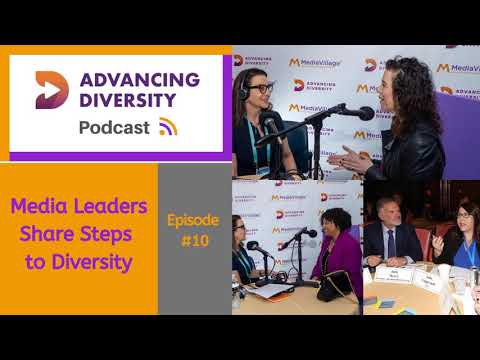Media Leaders Share Steps to Diversity: A Conversation With Coppernoll, Brand, and Kaplowitz

"Just as diverse as Twitter is, and how we elevate diverse voices and give them a platform every day, we want our company to represent the same things." That's the way Dalana Brand, Twitter's vice president of people experience, explained the social media giant's goals. That was a common sentiment from industry leaders attending the recent Advancing Diversity Hall of Honors, held during CES 2020. But what are the steps needed to increase diversity and inclusion (D&I) in the media and advertising industry?
I had the privilege of capturing the voices and ideas of a dozen esteemed attendees — ranging from Brand to Julie Coppernoll, corporate vice president, global marketing strategy at Intel, to Publicis Americas CEO Tim Jones, to the legendary Kay Koplovitz of Springboard Enterprises. As you'll hear in the coming weeks — as we roll out more episodes of the Advancing Diversity podcast — they share specific recommendations and points of view about what impacts them the most, both personally and professionally.
The following is an edited topline from the first episode captured during MediaVillage's Advancing Diversity Hall of Honors event. Episode 10 features Coppernoll, Brand, and Marla Kaplowitz, president and CEO of the 4As. I hope you'll listen to this 17-minute episode, and please subscribe and share from wherever you get your podcasts: Apple Podcasts, Stitcher, iHeartRadio, or YouTube.
Coming Together as a Community
After they described a "day in their lives,"I asked each executive, "What would you say is the most important action that we can take, together as a community, to help advance diversity and inclusion and move it from advocacy and talking about it to activism?"
Words — and numbers — matter:
Coppernoll points out that the word "community" gets used in so many different ways that it's important to define what it means for each individual organization; for example, she's trying to define it for women at Intel: "How do you build that intercompany community? And how do you get people actually supporting each other in ways that they haven't; [such as], if all of the women at your company got together on a regular basis, really got to know each other, so they could support each other, and stated what their goals were and what they want to be accountable for and responsible for — like, we want to be accountable for bringing more women into the organization — and then let them figure out how they want to go do it."
For Brand, the word together really resonated: "I think the keyword in your question is together. We've been talking about inclusion and diversity for a really, really long time and all of us, as companies and organizations, are trying to [solve for] this extremely wicked problem. But we're trying to do it ourselves. And there's not enough industry-wide focus and effort to get all the best practices and all the amazing thinking and all the research and the work that's been done and bring it together and really start to set standards together ... to set metrics together, to figure out ways to hold each other accountable. That's where change happens."
Kaplowitz pointed out those who are coming together, as well as the value in the measurement being done by the 4As and organizations such as She Runs It, with the #Inclusive100, (learn more in Episode 9 of the Advancing Diversity Podcast). "There are so many agencies and companies that each have their own program," Kaplowitz says. "This is not something that people need to be doing on their own. We don't need to keep reinventing new programs. When you find something that works, people should be open to sharing that....
"Diversity Best Practices actually measures what is happening within an individual company, and our goal for the #Inclusive100 is to make sure that we can get at least a hundred companies in the marketing and advertising space to participate. It's free…. It's about making sure that we can benchmark and understand because we need to measure to show that we can have that kind of impact and we need to be open about the severity of the issue.
On the topic of helping prepare the younger set of new media and marketing candidates to attract and retain high-caliber employees, Coppernoll says Intel aims to mentor them with empathy, suggesting those mentors say, "'Hey, look, we're going to have you come in and do a presentation on a competitive product' ... and push them through that exercise and assignments [because], when you're new in your career, you don't have any idea. And you're up against people that have been there for 10, 15, 20, 30 years. They know what to ask because they've seen it and they have that benefit. So, giving them the questions to ask, letting them go get the answers, then they learn."
That answer — education — speaks to one of the five steps Jack Myers outlines in his recommendations for how, together, we need to advance diversity. Kaplowitz says 4As is doubling down on that, especially in response to more and more agencies' requests to include business etiquette training. Those skills are now incorporated in its 12-week advertising and marketing virtual training program. She notes, "A lot of these students have never been in a business environment before. And, for those that already have experience that are also part of the program, they [get] the same kind of knowledge."
Brand described a specific way to open eyes and minds via Twitter's cultural intersectionality program: "We are teaching people day one ... in our orientation program about intersectionality.... They have the ability to put two or three things [on their employee badges] that they're passionate about or that represent them. And those become intersectional conversations in the car, in the cafeteria; looking at a badge and saying, 'Oh, I see you enjoy pop music' or 'I see you enjoy football' or whatever those things are, so we could teach people to appreciate the things that we have in common."
That answer dovetails with how Brand answered my last question to each of them: what inspires each media executive to take action in D&I. She said, "In terms of inclusion and diversity — in particular, for me — I get inspired by the conversations about how we are the same and similar. We spend so much time talking about the differences and encouraging people to appreciate the differences and value people that are different — and that's critically important and a part of it. But I have found that people open up tremendously when you can … share something you have in common. You have to get people to listen first and to have a conversation."
Listen to our full conversation and drive "intersectionality" by sharing this episode across our industry!
Don't stop now! Stay in the know on diversity and inclusion with more from Advancing Diversity Podcasts
Click the social buttons to share this story with colleagues and friends.
The opinions expressed here are the author's views and do not necessarily represent the views of MediaVillage.com/MyersBizNet.


